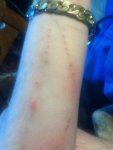Using a butterfly needle, like they use when getting blood samples, can help, and the 25 gauge ones I have used for medications are self-registering even with my low blood pressure, in other words blood will flow into the proximal half cm or more of the tubing connected to the needle, and I think one can get butterfly needles with translucent butterflies (the pieces of plastic right by the needle which are held with the finger and thumb to direct the needle) which show blood even further down.
What I do is prepare the syringe with the nicomorphine, hydromorphone, morphine, Scophedal, or whatever, get another syringe and draw saline into it, maybe 1-2 cc of saline in a 3 cc syringe or so and screw that into the butterfly and use that to flush the air from the needle and syringe . . . then I apply the tourniquet and sterilise the injection site -- actually since I sometimes have to poke more than one location just because I have tiny blood vessels, I will do the entire region like the inside of the forearm and spray the whole region with an atomiser of alcohol even before the tourniquet . . . then I put some tape on the tubing maybe 4-6 cm from the butterfly,
Then it is time to grasp the butterfly, get the needle in, and when it self-registers (in ambiguous cases I do pull back with the 3 cc with saline in it or the drug syringe after screwing it into the butterfly needle apparatus) push the tape down onto the skin with my nose or other hand or a pencil held in my teeth, then unscrew the saline syringe, screw in the drug syringe, and push the plunger, and do it at a moderate speed, then unscrew the drug syringe, screw in the 3 cc saline syringe and use 1 cc or so to push the rest of the drug in the tube into my vein, and take care of the tourniquet afterwards.
The butterfly needle can be used very easily with wheel filters and I have used inline IV filters and other things with extra pieces of tubing in some cases, like when I was using a syringe driver for a shot that had to be diluted to more than 5 cc or could make one pass out during the injection, and things like iron and Procrit and so forth and amounts of saline and glucose up the size of the largest syringe, 60 cc in my experience . . . one can use a syringe driver for that, or of course an IV setup with a stand and bags and tubes and inline filters and so forth can be used as well; I have both and especially used the syringe driver to push in 10 or more cc of dextromoramide diluted with 9‰ saline so I wouldn't faint from the blood pressure drop. That was when they started scripting Scophedal and then it was no longer available and I started getting it compounded . . . I still got the dextromoramide from time to time and would turn the syringe driver all the way up to maximum speed, so even if I did nod or pass out the shot would finish itself because it was not an overdose, it was orthostatic hypotension from when I would shoot the undiluted Palf into the main line with a single wham that took four seconds at most. The bang, which was necessary for tackling severe breakthrough pain, was even more than nicomorphine and comparable to phenadoxone plus hydroxyzine, both of which came in ampoules and I mixed in a 5 cc syringe and used with the syringe driver also and were even a hair better than Diconal and one didn't have to grind up pills with sand in them . . .



